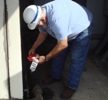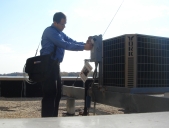
Achieving Compliance in Large Companies
Finding the correct frequency for auditing the program is one of the key elements in ensuring long-term success.
Lockout/tagout (LOTO) refers to specific practices and procedures to safeguard employees from the unexpected energization or startup of machinery and equipment or the release of hazardous energy during service or maintenance activities. LOTO has been on OSHA's list of top 10 most-cited regulations for more than 14 years and is currently the most-cited regulation for manufacturing.
 Most safety managers know it's important. However, when you’re balancing your budgets and have to decide where to put your money, LOTO compliance often is passed by because there's no easy solution simply to purchase. Final costs and costs to maintain a program often are seen as vague and difficult to calculate.
Most safety managers know it's important. However, when you’re balancing your budgets and have to decide where to put your money, LOTO compliance often is passed by because there's no easy solution simply to purchase. Final costs and costs to maintain a program often are seen as vague and difficult to calculate.
The only way to achieve lockout/tagout compliance with any company (large or small) is to buy completely into the idea that the problem might be more complex than initially thought. Your company may need assistance when implementing the new program to ensure all essential elements are covered right from the start.
The Basics
All companies need five elements to achieve and maintain LOTO compliance:
1. Training (Authorized and Affected)
2. Machine-specific procedures
3. Policy
4. Devices, locks, and tags
5. Annual auditing (all procedures and authorized employees)
All of these elements can be easily understood by researching 1910.147 on the OSHA.gov website, but here's what you won't find and tips that often are not followed:
1. Training (Authorized and Affected)
a) You can train your employees in groups. For Authorized employees, make sure you include a hands-on demonstration as a group to ensure full comprehension.
b) Make sure your trainings are related to your equipment and not just a generic training template that was downloaded from somewhere.
2. Machine-specific procedures
a) Most companies miss the fact that they need unique procedures for nearly all of their equipment on the premises. It doesn't matter whether your equipment is leased or you don't work on it; OSHA makes it the responsibility of the company that is occupying the space to ensure machine-specific procedures are created for all equipment that needs it.
b) Typically, 95 percent of all of your equipment requires a machine-specific procedure according to the criteria set forth in 1910.147(c)(4)(i). All equipment must meet eight criteria before it is exempt from requiring a procedure. Many people think it doesn't need a procedure if it's cord and plug, but that's just not true. It must meet all eight criteria.
3. Policy
a) Use your policy to detail your means of enforcement, responsibilities, and frequency for auditing and how to deal with contractors on site. A good policy should be easy to understand and frequently updated as conditions in the business change.
4. Devices, locks, and tags
a) Make sure you research the correct devices and locks for your facility before ordering. There are many manufacturers of devices and locks, and some are far better than others with respect to both performance and price.
5. Annual auditing
a) This is the second-most-common deficiency cited (after not having lockout/tagout procedures). Companies that implement a perfect lockout/tagout program will need to understand its proper maintenance intervals in order to ensure the program stays intact. At a minimum, OSHA requires that companies review every procedure at least annually, in addition to reviewing at least a respective sampling of authorized employees at least annually.
After Implementation -- Now What?
Whether outsourcing the implementation of a lockout/tagout program to consultants to create it for you or taking on the burden of creating a program in house, there is a considerable expense to gaining compliance. Consider that if you have 1,000 employees and 1,000 pieces of equipment, you are likely to spend between $100,000 and $300,000 to implement a new program from scratch (in house or outsourcing). All of that investment will go to waste if it's not properly maintained.
Unfortunately, there is not an exact maintenance interval that is right for every business. Hospitals, for instance, typically choose to audit their programs at the minimal required level. In this case, annual audits might be appropriate because of their minimal equipment change rates (5 percent equipment change is typical every year). A manufacturing facility, on the other hand, might have equipment change rates of 15-50 percent every year.
Unless each equipment change was accurately captured on the lockout/tagout procedure right when the change was made, waiting until the end of the year to catch any non-compliant procedures might be waiting too long. Other factors that might affect how often you audit your program include in-house resource availability, funding for auditing, accessibility to equipment, and increased exposures to hazards by auditing. With all of the constraints, it's difficult to make any move without second guessing your efforts.
Two Case Studies
Below are some typical guidelines based on two unique scenarios for large businesses.
Business 1: Manufacturing business with eight locations around the United States
Problem: It has an old, text-based LOTO procedures program in place. Although it is compliant with OSHA's minimum standards, authorized employees are still getting hurt because of failing to lock out equipment when servicing it. The company has sent out memos stressing the importance of locking out equipment when servicing but has seen no reduction of near-misses or accidents.
Scope: Eight locations with approximately 200 pieces of equipment and 30 authorized employees per location.
Proposed solution: Use outside experts to implement a new, picture-based LOTO system. Label all isolation points with graphical tags and mount graphical lockout/tagout procedures at the point of use on all equipment. Provide new LOTO training with outside experts to engage the authorized employees with actual scenarios. Implement a new corporate LOTO policy and ensure all authorized employees read and understand the policy. Audit 50 percent of the program once per quarter to ensure procedures are fully updated. Perform random audits of 10 employees during each quarterly audit and ensure all employees are eventually audited throughout the year. Utilize outside experts to audit the program after the first year, then every other year, to ensure the program is properly maintained. Utilize findings to implement updates in the program and program maintenance intervals.
Result: This business has seen immediate changes in the authorized employees' attitude toward lockout/tagout. Additionally, the company has seen a reduction of workplace accidents, injuries, and near-misses because of the proper use of LOTO. Lastly, productivity has increased because of the ease with which lockouts are now implemented and the reduction of accidents. With all equipment and isolation points clearly and visually labeled, utilizing the LOTO procedures has become more second nature and less of a burden for the authorized employees.
Business 2: Hospital network with 200 locations across the United States
Problem: It has been audited by OSHA and found to be deficient at one of the locations. To ensure it does not lose accreditation and funding, the network needs to establish and maintain compliance system wide.
Proposed Solution: Same solution as Business 1, but with these changes regarding maintenance interval: Audit program (procedures and authorized employees) once per year to ensure all procedures are accurate. If auditing in house, use outside experts to audit entire program once every two to three years to ensure the program's integrity is maintained. Utilizing outside sources ensures an unbiased review and a new set of eyes to identify issues that might have been overlooked otherwise.
Result: Compliance is established within a few months, and the new graphical LOTO program is easy to maintain with minimal impact on in-house resources. The annual equipment change rates are found to be approximately 6 percent; half of the procedures were updated correctly when the equipment was changed, and the other half were identified during the annual audit. A decision was made to bring in an outside firm every three years to ensure the program's accuracy never falls too low.
Conclusion
As you can see, two vastly different businesses still have closely similar LOTO implementation solutions. The similarities stop at implementation, however, because they require different maintenance intervals. Finding the correct frequency for auditing your lockout/tagout program depends on the needs of your business and is one of the key elements in ensuring long-term, successful sustainability.
This article originally appeared in the September 2010 issue of Occupational Health & Safety.
About the Author
Jimi Michalscheck is the business development manager for Rockwell Automation, Inc. and was formerly the CEO of ESC Services, Inc. before it was acquired by Rockwell Automation in 2014. ESC Services is an engineering business unit focused on delivering advanced safety services and solutions that yield a balanced approach to enhance both safety and productivity. Visit www.escservices.com to learn more about the modern safety solutions available today or to connect with an ESC engineer for professional guidance.